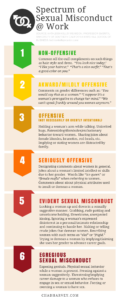How to Talk About Sexual Misconduct at Work

We’re living through a long overdue cultural adjustment where inappropriate workplace behavior is getting called out and punished. However, we still lack an objective framework for centering our discussions before offensive behavior occurs.
I’ve discharged employees for misconduct (including sexual misconduct), and in all cases the offensive behavior was clear-cut. But in less obvious instances, where exactly are the lines drawn and what do they feel and sound like?
I’d been thinking about this issue for some time when one of my clients told me he had recently terminated a key employee for sexual misconduct. The objectionable behavior manifested in such a way that the dismissal was clearly justifiable. Yet the overall question for the business owner remained: How could he discuss sexual misconduct within his company in an objective manner?
Enter Professor Kathleen Kelley Reardon and the Spectrum of Sexual Misconduct at Work.
I recently discovered an article and a series of posts crafted by Dr. Reardon, Professor Emerita of the University of Southern California Marshall School of Business, that outline her vision for the Spectrum of Sexual Misconduct at Work (SSMW). We’ve used Professor Reardon’s research to create the SSMW graphic that you see on this page as well as a downloadable PDF that you can use at your organization.
Dr. Reardon developed the SSMW from “interviews and interactions with hundreds of women in a wide variety of fields” with these four specific purposes in mind:
- Create a blueprint for both men and women that can be used to understand how different levels of offense “harm work relationships and create or perpetuate hostile work environments.”
- Provide a way to discuss sexual misconduct and halt backlash against women for doing so.
- Assist women with deciding “when and how to respond” to offensive behaviors.
- Provide a framework for organizational training.
I work with both male and female leaders, and I understand that many feel uncomfortable discussing the subject of sexual misconduct. Most would prefer to offload these conversations to HR, and I believe that this stems from the lack of a framework to discuss the issue. The SSMW solves this by moving discussions out of a theoretical grey area and into the real world.
I hope that our graphic of Professor Reardon’s work will better equip leaders to discuss the differences between appropriate and inappropriate behaviors—and help them prevent offensive behaviors from happening. You may download the PDF here, and please weigh in with a comment or drop me a line. I’d love to know how you’re tackling this issue in your organization and whether the SSMW is helpful to you.
Here’s to a better, safer, more inclusive workplace.

